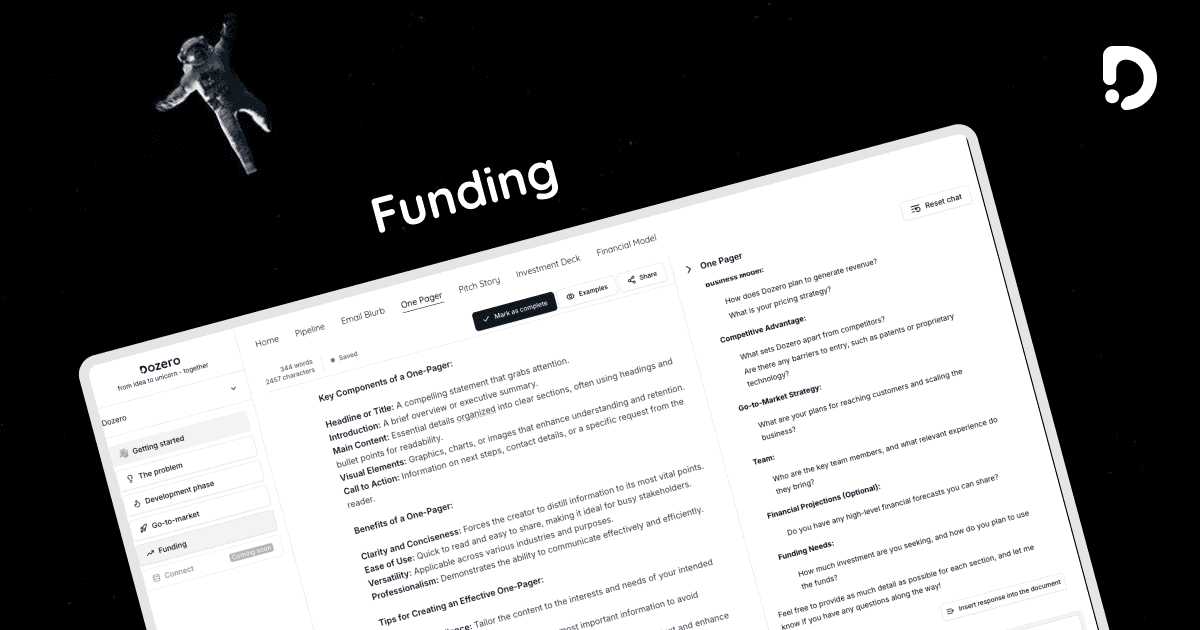< Back
Funding
Financial Model
Nov 6, 2024
A financial model is a quantitative tool that represents a company's historical, current, or projected financial performance. It's typically built using spreadsheet software like Microsoft Excel and is designed to forecast future financial results based on a set of assumptions and variables. Financial models are essential for decision-making processes in finance, investment, and business strategy.
Purpose of a Financial Model:
Forecasting: Project future revenues, expenses, and cash flows to anticipate financial performance.
Valuation: Estimate the value of a business, project, or investment using methods like discounted cash flow (DCF) analysis.
Decision-Making: Assess the financial implications of strategic decisions such as mergers and acquisitions, capital investments, or entering new markets.
Risk Analysis: Evaluate potential risks and uncertainties by running sensitivity analyses and scenario planning.
Budgeting and Planning: Aid in creating budgets, setting financial targets, and aligning operational activities with financial goals.
Components of a Financial Model:
Income Statement (Profit & Loss Statement):
Projects revenues, cost of goods sold (COGS), gross profit, operating expenses, and net income.
Balance Sheet:
Forecasts assets, liabilities, and shareholders' equity over time.
Cash Flow Statement:
Details cash inflows and outflows from operating, investing, and financing activities.
Assumptions and Drivers:
Key variables such as growth rates, margins, interest rates, tax rates, and working capital requirements.
Supporting Schedules:
Detailed calculations for items like depreciation, amortization, capital expenditures, debt schedules, and inventory turnover.
Valuation Analysis:
Methods like DCF, comparable company analysis, and precedent transactions to estimate enterprise and equity value.
Sensitivity and Scenario Analysis:
Examines how changes in key assumptions affect outcomes, testing best-case, worst-case, and base-case scenarios.
Types of Financial Models:
Three-Statement Model:
Integrates the income statement, balance sheet, and cash flow statement into one cohesive model.
Discounted Cash Flow (DCF) Model:
Values a company or asset based on its projected future cash flows discounted back to present value.
Merger & Acquisition (M&A) Model:
Assesses the financial impact of a merger or acquisition, including synergies and purchase price allocation.
Leveraged Buyout (LBO) Model:
Evaluates the feasibility and returns of acquiring a company using a significant amount of borrowed funds.
Budget Model:
Used internally to plan and monitor a company's financial performance against budgets.
Consolidation Model:
Combines the financials of multiple business units or subsidiaries into a single model.
Option Pricing Model:
Uses mathematical models like Black-Scholes to value options and other derivatives.
Importance of Financial Models:
Informed Decision-Making:
Provides a quantitative basis for strategic decisions, investments, and resource allocation.
Risk Management:
Identifies potential financial risks and helps in developing mitigation strategies.
Investor Communication:
Facilitates transparent discussions with investors, lenders, and stakeholders about financial expectations.
Performance Tracking:
Enables comparison of actual results against projections to measure performance and adjust strategies accordingly.
Best Practices in Financial Modeling:
Accuracy and Consistency:
Double-check formulas and ensure consistent use of units and formats.
Transparency:
Clearly document assumptions, sources, and methodologies.
Flexibility:
Design models that are easy to update and adjust as new information becomes available.
Clarity:
Use logical organization, labeling, and formatting to make the model easy to understand.
Validation:
Test the model with different scenarios to ensure it behaves as expected.
Skills Required for Financial Modeling:
Accounting Knowledge:
Understanding of financial statements and accounting principles (GAAP or IFRS).
Excel Proficiency:
Advanced skills in Excel functions, formulas, and possibly VBA macros.
Financial Analysis:
Ability to interpret financial data and understand key financial ratios and metrics.
Attention to Detail:
Precision in building models to prevent errors that could lead to incorrect conclusions.
Analytical Thinking:
Capability to analyze complex information and draw meaningful insights.
Applications of Financial Models:
Corporate Finance:
Capital budgeting, fundraising, dividend policy decisions, and financial planning.
Investment Analysis:
Evaluating stocks, bonds, real estate, and other investment opportunities.
Project Finance:
Assessing the viability and funding requirements of large-scale projects.
Strategic Planning:
Exploring the financial impact of strategic initiatives like entering new markets or launching new products.
Risk Management:
Stress testing financial stability under adverse economic conditions.
Conclusion:
A financial model is an indispensable tool that enables businesses, investors, and financial professionals to simulate the financial performance of a company or project. By incorporating various assumptions and variables, it helps stakeholders anticipate future outcomes, make informed decisions, and strategically plan for growth and sustainability.
This financial model example is a template that you can use to build your financial model, to do so, simply copy it to your drive, or download it.

